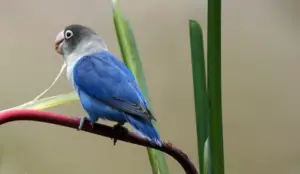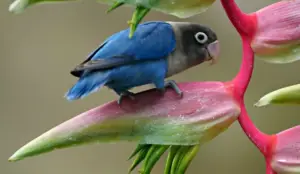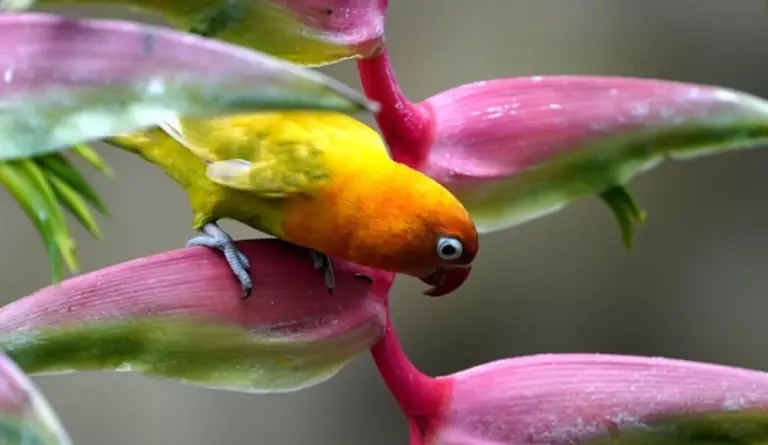Welcome to the colorful and captivating world of lovebirds! If you’ve ever wondered, “What does a lovebird look like?”, you’re in for a delightful discovery. These small, vibrant parrots are not just a feast for the eyes with their stunning hues, but they also capture hearts with their playful and affectionate nature.
In this introduction, we’ll embark on a journey to explore the unique appearance of lovebirds, unveiling the beauty and charm that make them one of the most beloved pet birds around the globe. Whether you’re a bird enthusiast, a potential pet owner, or simply curious about these feathered wonders, you will uncover the enchanting world of lovebirds and their mesmerizing appearance.
What Does a Lovebird Look Like?
Lovebirds are small, brightly colored parrots, typically measuring around 6 inches in length. They are known for their vibrant plumage, which varies significantly across different species.
Lovebirds boast a rainbow of colors in their plumage, with shades ranging from greens and blues to reds and yellows. Each species has its unique color pattern, making them a delight for bird enthusiasts. For instance, the Peach-faced Lovebird is adorned with a beautiful blend of greens with a peachy-pink face, while the Fischer’s Lovebird showcases a striking combination of green, orange, and blue. Their beaks are short and stout, ideal for cracking seeds, and they have round, expressive eyes that add to their endearing appearance.
Why Lovebirds are Colorful: Understanding Their Feather Patterns

Lovebirds are colorful to attract mates and to blend in with their natural environment.
The vivid colors of lovebirds serve several purposes. Primarily, these colors are a mechanism for attracting mates; the brighter and more vibrant the plumage, the more appealing the bird is to potential partners. Additionally, their colors help them blend into their natural habitats, which are often filled with colorful flora. Genetics play a crucial role in determining the coloration of a lovebird, and environmental factors can also influence the vibrancy of their feathers.
How to Differentiate Between Male and Female Lovebirds
Male and female lovebirds look very similar, but subtle physical and behavioral differences can often differentiate them.
Unlike many other bird species, lovebirds do not exhibit prominent sexual dimorphism, meaning males and females look quite similar. However, there are subtle differences. Males tend to be slightly larger with a more rounded head, while females usually have a stockier build. Behaviorally, females may exhibit more nesting and shredding behavior, especially during breeding seasons.
The Importance of Understanding Lovebird Behavior
Understanding lovebird behavior is crucial for their well-being and to form a strong bond with them.
Lovebirds are social and affectionate birds. They enjoy interacting with their human companions and often form strong bonds. They are known for their playful nature, often engaging in activities like swinging, climbing, and chewing toys. Recognizing their social needs is vital; lovebirds that are left alone for extended periods can become lonely and depressed. Observing their behavior closely can also help in identifying any signs of stress or illness.
How to Create a Comfortable Habitat for Lovebirds
Creating a cozy and inviting home for your lovebirds is essential for their happiness and well-being. When setting up a habitat, think of it as crafting a miniature world where they can play, rest, and feel secure. Let’s dive into the details of how to create this perfect haven for your feathered friends.
Spacious Cage
The first step in creating a comfortable habitat is choosing the right cage. Lovebirds need space to spread their wings and fly a bit. A cage that’s at least 24 inches long, 18 inches wide, and 24 inches high is a good start. But remember, bigger is always better when it comes to bird cages. This space is not just for flying; it’s where your lovebirds will eat, sleep, and play, so they need room to move around freely.
Varied Perches
Perches are like the furniture of your bird’s home. Just as we need different types of seating, lovebirds need perches of various sizes and textures. This variety helps keep their feet healthy and strong. You can choose from natural wood perches, which help mimic their natural environment, to rope perches that provide a softer footing. Arranging these perches at different heights and angles will also encourage movement and exercise.
Safe and Fun Toys
Lovebirds are naturally curious and playful, so their habitat should be a place of exploration and fun. Toys are not just for entertainment; they are crucial for your bird’s mental and physical stimulation. Look for safe, bird-friendly toys that they can chew, as lovebirds love to nibble and shred. This activity is not only enjoyable for them but also helps keep their beaks in good shape. From hanging bells and ladders to chewable wood blocks and ropes, there’s a variety of toys available to keep your lovebird engaged and happy.
Placement of the Cage
Where you place the cage in your home is as important as the cage itself. Lovebirds prefer a quiet yet social area, where they can observe the household activities without being in the middle of chaos. Avoid placing the cage in direct sunlight, as this can get too hot for them. Similarly, keep the cage away from drafts, as sudden temperature changes are not good for their health. A spot that’s well-lit during the day and quiet at night is ideal.
In summary, creating a comfortable habitat for lovebirds is about balancing space, stimulation, and safety. A spacious cage, diverse perches, engaging toys, and a strategically placed cage will ensure your lovebirds feel at home. Remember, a happy lovebird is a healthy lovebird, and the effort you put into their habitat will be rewarded with their cheerful chirps and playful antics.
What to Feed Your Lovebird: Nutrition and Diet Tips

A healthy diet for a lovebird includes a mix of pellets, seeds, fruits, and vegetables.
Nutritional Guidance: While pellets should form the bulk of their diet, providing about 60-70%, seeds can be given in moderation as they are high in fat. Fresh fruits and vegetables are crucial for providing essential vitamins and minerals; however, avoid avocado and chocolate, as they are toxic to birds. Ensure that their diet is varied to prevent boredom and nutritional deficiencies.
Common Health Concerns in Lovebirds and How to Address Them
Common health concerns in lovebirds include respiratory issues, feather plucking, and nutritional deficiencies.
Healthcare Tips: To prevent these issues, ensure your lovebird has a balanced diet, a clean and safe environment, and regular exercise. Watch for signs of illness, such as changes in eating or sleeping habits, and consult a vet if you notice any unusual symptoms. Regular check-ups with an avian vet are also recommended.
Bonding with Your Lovebird: Tips and Tricks
Bonding with a lovebird involves spending quality time, gentle handling, and consistent interaction.
Bonding Techniques: Spend time each day interacting with your lovebird, talking and playing with them. Hand-feeding treats can help build trust, as can gentle handling and allowing them out of their cage under supervision. Remember, each bird has its personality, so be patient and let your lovebird set the pace for bonding.
FAQ about lovebird look like
What is the average lifespan of a lovebird?
Lovebirds typically live between 10 to 15 years, though with excellent care, some can live even longer.
Can lovebirds talk or mimic sounds?
Lovebirds are not known for their ability to mimic human speech, but they can learn to mimic some sounds and whistles.
Are lovebirds suitable pets for families with children?
Yes, lovebirds can be great family pets, but it’s important to supervise interactions between children and birds to ensure safety for both.
How often should lovebirds be let out of their cage?
Lovebirds should be let out of their cage daily for at least an hour under supervision for exercise and mental stimulation.
Can lovebirds be kept with other bird species?
While lovebirds can get along with other birds, careful introduction and monitoring are necessary to ensure compatibility.
Conclusion
In conclusion, exploring the world of lovebirds has been a journey full of vibrant colors and charming behaviors. From understanding “what does a lovebird look like” to learning how to create a comfortable habitat for them, we’ve covered the essential aspects of lovebird care. These delightful birds, with their bright feathers and endearing personalities, make wonderful companions for those who are willing to invest time and love into their care.
As we close this chapter, remember that the beauty of lovebirds goes beyond their striking appearance; it’s also found in the joy and companionship they bring into our lives. Whether you’re a seasoned bird lover or new to the avian world, the allure of lovebirds is undeniable, and their care is a rewarding experience.

Hi, I’m Regina Rios. Just another bird lover who loves to share knowledge from personal experience. I’ve grown up with pet birds since childhood as my mommy also loves birds. As I can’t pet many birds in open air in my house as my mom does; I created my first bird cage on my rooftop using wood, copper wire, and a metal shed in 2018 and start collecting pet birds. Now, I have so many pet birds such as Macaws, Parrot, Cockatiel, Parakeet, and others. Not only that, if I see natural birds are injured I keep them in my house until they get well. Now, my hobby becomes my income source as my home birds have babies and I sell them to birds lover like mine. I’ve created this blog to inspire others bird owners by sharing my personal knowledge. Good Luck!


